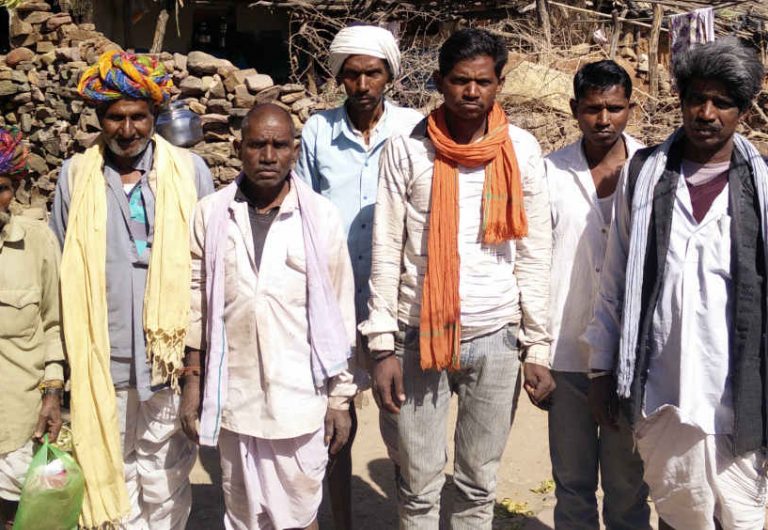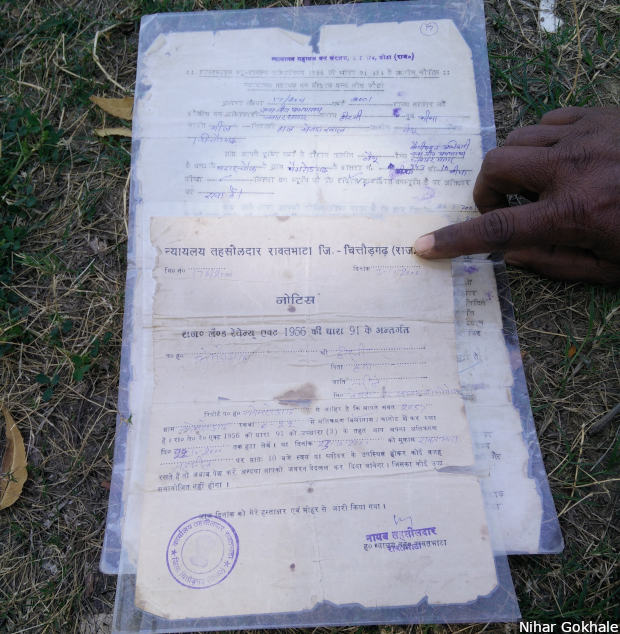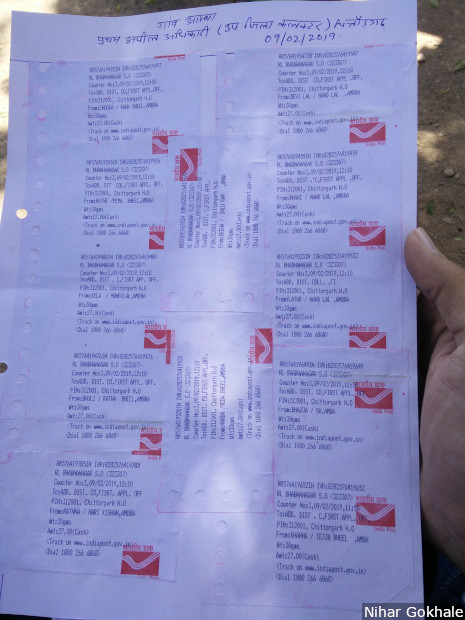Chittorgarh (Rajasthan): Breaking the law isn’t something one is usually proud of. But for Devi Lal, a resident of a forest village in southern Rajasthan, a court summons for encroaching on forest land in 2002 is a prized possession.

Devi Lal (second from left) and 60 others in the villages of Rawatbhata block of Chittorgarh district in southern Rajasthan had applied for land titles. The applications were rejected in 2015, and they were never informed of the rejection, in violation of the Forest Rights Act.
A quiet, tall man dressed in a dhoti, kurta and a colourful turban, the 64-year-old from an indigenous community called Bhils, proudly showed off the terse order–neatly laminated and stored in a bag–that demanded his presence before a forest official’s court, where he would stand trial.
Since the Forest Rights Act (FRA) was introduced in 2006, these summons became evidence that Devi Lal had lived on the land in question before that, and became vital evidence to support his claim under the Act (see ‘How claims are filed and rejected’ below).

The summons and notices issued to Devi Lal and 60 other Bhil tribals for encroaching on forest land in 2002 are now evidence of their claims under the Forest Rights Act.
Nearly three years after he and 60 others in the villages of Rawatbhata block applied for land titles, the applications were rejected in 2015. They do not know why; they were never informed of the rejection, a violation of the FRA, which says that decisions to reject or modify claims have to be communicated to the claimant in person, so that they have the opportunity to appeal the rejection within 60 days.
They could not appeal against the rejection because they were never informed that it was rejected.
They were not even given a chance to appeal their case before the rejection order was passed, another violation of the law, which says that no claim will be disposed of against a claimant without giving them a reasonable opportunity to present their case.
Such government violations of the law are common not just in Rajasthan but nationwide, as 1.9 million families of indigenous people–roughly 9.5 million people at five persons per family–are at risk of being evicted from their homes in forests.
Such violations include, as this story will detail, allowing forest guards to illegally decide claims and demands made by governments, and asking tribals to furnish satellite imagery and non-existent 75-year-old records.
On February 13, 2019, the Supreme Court ordered that all households whose rights claims under FRA have been rejected should be evicted from forests by July 2019. After widespread criticism and protests from tribal groups and conservation scientists, and a petition by the central government, the Supreme Court temporarily stayed its own order on February 28, 2019.
The 21 states involved (Andhra Pradesh, Assam, Bihar, Chhattisgarh, Goa, Gujarat, Himachal Pradesh, Jharkhand, Karnataka, Kerala, Madhya Pradesh, Maharashtra, Manipur, Odisha, Rajasthan, Tamil Nadu, Telangana, Tripura, Uttarakhand, Uttar Pradesh and West Bengal) must now explain to the Supreme Court how the FRA claims were accepted or rejected.
The petitioners before the Supreme Court, namely Wildlife First, Nature Conservation Society and Tiger Research and Conservation Trust, have argued that rejection of an FRA claim implies that the claimant is an encroacher and not a bona fide forest dweller.
But growing evidence from the ground–as IndiaSpend reported from Chhattisgarh in November 2018–indicates that a large number of rejections were illegal and arbitrary.
How claims are filed and rejected
The Forest Rights Act recognises individual rights of tribals over forest areas, if they can prove occupation before December 13, 2005. The claims over forest lands are processed through a three-tier system: the gram sabha, or general assembly of the village where the claims are first submitted; a sub-divisional-level committee (SDLC) headed by a government officer; and a district-level committee (DLC) headed by the district collector.
Every forest claim must be accompanied by two documents as evidence, which could be: documents issued by the government; research studies; statement by elders; and even physical evidence of possession or use of land, such as wells.
Here is how the claims are processed: Accompanied by officials from the revenue and forest departments, the gram sabha’s forest rights committee verifies claims by a field visit, collecting additional evidence, if needed, from claimants and witnesses. The committee then submits its opinion to the gram sabha, which approves or rejects the claim.
Approved claims are forwarded to the SDLC for review. If approved, the claim is forwarded to the DLC, which is the final legal authority to approve or reject claims.
Appeals against rejection follow the same order. If the gram sabha or SLDC rejects a claim, the claimant can appeal to the SDLC or DLC.
The law says that claimants must be granted a personal hearing before claims are rejected, and they must be given–in writing–the reasons for rejection.
But, as our investigations revealed, the process does not work as it should.
Demanding satellite imagery, 75-year-old documents from tribals
As of November 2018, nearly half (46%) of all FRA claims had been rejected nationwide, according to the latest monthly progress report prepared by the Ministry of Tribal Affairs.
Adivasis (forest dwellers), experts–and, increasingly, the courts and the government–have not been convinced that every other forest dweller in India is actually a post-2005 encroacher.
In Jharkhand, decisions on forest rights claims are often influenced by the local forest department, said Father George Monipally, a priest based in Latehar in central Jharkhand, who has worked on forest rights in the state. “Only the village-level bodies are empowered to verify claims but the committees often take decisions based on statements by forest officials,” he said.
In Chhattisgarh–where forests cover 41% of the area and a third of the 25 million population belongs to a scheduled tribe–meaning one of the 645 indigenous communities protected by the Constitution–the government illegally included patwaris (village-level revenue officials) and forest guards in the forests rights committees, said Tushar Dash, an independent forest rights researcher in Odisha.
“More than half the rejections in Chhattisgarh were found to be at the gram sabha level,” said Dash. “But many of these rejections were decided by forest guards or patwaris.”
One case documented by Land Conflict Watch, an independent network of researchers and journalists documenting land conflicts across India, revealed how a forest-rights claim was rejected by a range forest officer on the grounds that the claimant did not live on the land before 2005. Range officers are not authorised to reject FRA claims; they can only provide recommendations to claims committees.
Although the FRA rules list numerous kinds of admissible evidence, including statements from village elders, permanent improvements to land such as bunds, and genealogy tracing ancestry to persons mentioned in old land records, states often make additional demands that are not a part of the Act.
In Gujarat, for instance, a third of the 118,000 claims filed until 2008 were rejected by SDLCs due to “insufficient evidence”, according to a Gujarat High Court judgement delivered in 2013. The government insisted on records of the forest department as documentary evidence, and demanded satellite imagery to be sourced only from a Gandhinagar institute, the Bhaskaracharya Institute for Space Applications and Geo-Informatics, according to the petitioners in the High Court case, the Gujarat-based non-profit, Action Research in Community Health and Development.
The Gujarat government also decided to process only those claims that could prove possession before 1980, contrary to the law. In its 2013 verdict, the Gujarat High Court struck down these requirements, observing that “to demand from such a class of citizens strict proof as regards their rights would frustrate the very object with which the Act has been enacted”. The court also asked for a review of rejected claims.
The problem of evidence is worse for “other traditional forest dwellers”–those who do not belong to a scheduled tribe–who need to prove “continuous existence” in the forest for 75 years.
“Karnataka put in a rule that said even the documents submitted as proof have to be 75 years old,” said a former consultant to India’s ministry of tribal affairs, speaking on condition of anonymity. “How is that even possible especially for a forest-dwelling family? Would that document not turn into dust?”
In a statement issued in March 2018, the ministry said that it had asked chief secretaries of state governments where the rejection rates are high, to “mandatorily” review all such claims from April 1, 2014.
As of November 2018, the latest month for which data are available, Chhattisgarh had rejected most individual claims (455,000), followed by Madhya Pradesh (350,000) and Maharashtra (120,000).
The missing files of Chittorgarh
Devi Lal and others of the Rawatbhata block, as we said, were never informed that their claims were rejected or why.
The tribals filed the claims between 2010 and 2012 to their homes and agricultural fields, no more than a hectare each–size of two football fields.
That was the last they saw of their claim papers.
They did not get a receipt or any acknowledgement that the file was received, and had not kept a copy for themselves.
“We went to the panchayat a number of times,” said Devi Lal. “But every time they said the file was under process.”
None of them recollected any field verification of their homes or farms by the forest rights committee. Not having heard about their claims, the farmers prepared fresh applications in 2017, but when they tried to submit these to the gram panchayat, they were told that their earlier claims were rejected by the SDLC, so they could not file a new claim.
That is when the farmers began filing applications under the 19-year-old Right To Information (RTI) Act to track their claims.

Postal receipts of the right-to-information requests filed by the Bhils of Rawatbhata block in Rajasthan’s Chittorgarh to track their claims under the Forest Rights Act.
The documents they sourced through RTI showed that the gram panchayat–a body of elected representatives that governs a village–had in 2012 sought records from the forest department for each of the claims, and a letter from the department had acknowledged that the request was under process. There is also an undated document from the SDLC listing 61 rejected claims, including all applicants from two hamlets, Amba and Bevda ki Khal.
The SDLC’s actions violate several of FRA provisions, such as Section 12 (A) (3) that says a rejection should be conveyed “in person” so that the claimant can file an appeal within 60 days; and Section 12 (A) (10) that says the reasons for rejection must be recorded in writing.
Instead, the RTI responses suggest that even a forest rights committee was not formed in the village when the claims were rejected. The forest rights committee was constituted only in June 2018, three days after an RTI was filed seeking the names of the committee members, according to RTI responses reviewed by this reporter.
The committee had five members, though the law says it should have no fewer than 10. There were no women representatives, as the law says there must be. There was a “vice president” appointed to the committee, an illegal position.
“We went to the houses of the FRC [ forest rights committee] members,” said Devi Lal. “None of them had any idea that they were on any such committee. Some of them work in the panchayat and were simply made members.”
Confusion among officials, invalid reasons for rejection
Amit Kumar Verma, the sub-divisional magistrate and head of the SDLC, said he was not aware of the case of Devi Lal or the others, as he had taken charge only in late 2018. But, Verma said, his office was willing to rectify any errors, if “brought to my notice” by the applicants.
According to the files that Verma examined before this reporter, the SDLC had dispatched the orders rejecting the 61 claims on June 4, 2015. However, copies of the orders or the reasons for rejecting them were not available in Verma’s office. Verma said all the orders and files had been dispatched to the office of the panchayat samiti, an intermediate office between the sub-divisional magistrate and the panchayats.
At the samiti office, the block development officer, ML Sharma, said he, too, had taken charge only recently, but according to his office records, the forest rights rejection orders had been forwarded to the Bhainsrorgarh village panchayat–which governs the hamlets where Devi Lal and other claimants live–to be distributed to the claimants.
At the panchayat, an official who did not wish to be identified went through all forest-rights records, but found no record of FRA rejections. The officer said the files appeared to have never returned from the samiti office.
In the panchayat samiti and gram panchayat offices, officials gave reasons for rejecting the claims but on condition of anonymity. The reasons varied: Some said the land was unsurveyed, others said the claims were rejected because the hamlets Amba and Bevda ki Khal fall within the nearby Jawahar Sagar Wildlife Sanctuary.
None of these are valid reasons under the law. The claimants have indeed received encroachment notices from the forest department, but if a wildlife sanctuary is involved, the FRA states that the relocation of forest dwellers is only the last resort; rights must first be settled.
Not informing claimants about rejections is not unique to Rajasthan.
Courtesy: India Spend
A 2017 audit of the Odisha state government by the Comptroller and Auditor General of India, which checked 51 rejected claims, found 35 to have been “irregularly rejected” and their claimants “not intimated about the rejection”.
In a plea filed before the Supreme Court on February 27, 2019, the tribal affairs ministry argued that the court’s order should be modified to stall evictions until all states had reviewed the rejections. The affidavit said the ministry was aware of concerns around rejections, including a high rate of rejections and “non-communication of rejection order (sic)”.
Back in Chittorgarh, such a modification might provide not just relief from eviction but perhaps also help locate the documents the Bhils filed seven years ago to claim their land rights.
“The district administration just makes people run around between offices, giving reasons orally,” said Bapu Nath of Buld Mazdoor Kisan Samiti, a local advocacy that has helped Bhil farmers file claims and RTI applications.
“Without a written order, they [the Bhils] cannot appeal or know if they could have corrected the claim application,” said Nath. “Because of our RTIs, at least they began digging out old files.”
(Gokhale is a contributing writer with Land Conflict Watch, an independent network of researchers and journalists documenting land conflicts across India.)